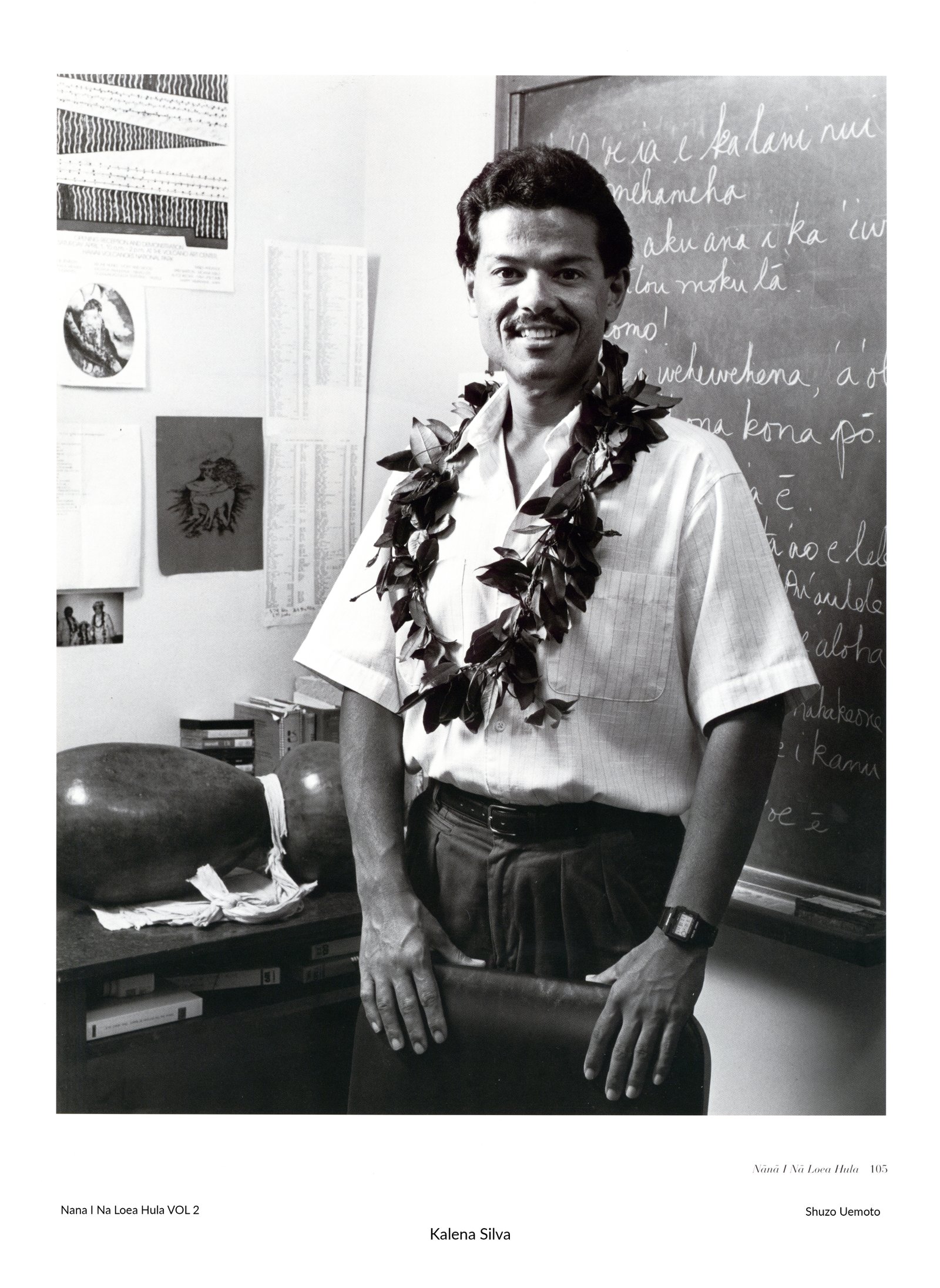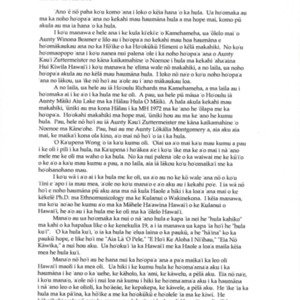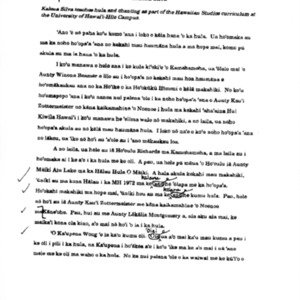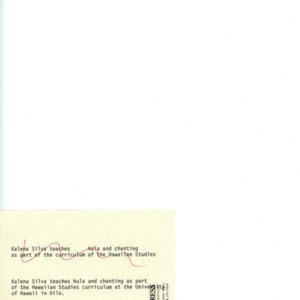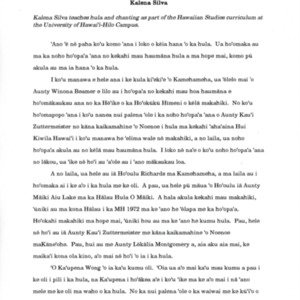Kalena Silva
Title
Kalena Silva
Subject
Nā Kumu Hula Kalena Silva - Nānā I Nā Loea Hula Volume 2 Page 104
Description
Kalena Silva teaches hula and chanting as part of the Hawaiian Studies curriculum at the University of Hawai'i- Hilo Campus.
‘Ano ‘e nō paha ko‘u komo "ana i loko o kēia hana ‘o ka hula. Ua ho‘omaka au ma ka noho ho‘opa‘a ‘ana no kekahi mau haumāna hula a ma hope mai, komo pū akula au ma ia hana ‘o ka hula.
I ko‘u manawa e hele ana i ke kula ki‘eki‘e ‘o Kamehameha, ua ‘ōlelo mai ‘o Aunty Winona Beamer e lilo au i ho‘opa‘a no kekahi mau hoa haumāna e ho‘omakaukau ana no ka hōʻike o ka Ho‘okūkū Hīmeni o kēlā makahiki. No ko‘u ho‘omaopopo ‘ana i ko‘u nanea nui palena ‘ole i ka noho ho‘opa‘a ‘ana o Aunty Kau‘i Zuttermeister no kana kaikamahine ‘o Noenoe i hula ma kekahi ‘aha‘aina Hui Kiwila Hawaiʻi i koʻu manawa he ‘elima wale nō makahiki, a no laila, ua noho ho‘opa‘a akula au no kēlā mau haumāna hula. I loko nō na‘e o ko‘u noho ho‘opa‘a ‘ana no lākou, ua ʻike no hoʻi au ‘a‘ole au i ‘ano mākaukau loa.
A no laila, ua hele au iā Ho‘oulu Richards ma Kamehameha, a ma laila au i ho‘omaka ai i ke a‘o i ka hula me ke oli. A pau, ua hele pū māua ‘o Ho‘oulu iā Aunty Mā‘iki Aiu Lake ma ka Hālau Hula O Māʻiki. A hala akula kekahi mau makahiki, ‘ūniki au ma kona Hālau i ka MH 1972 ma ke kūlana he ‘ōlapa me ka ho‘opa‘a. Ho‘okahi makahiki ma hope mai, ‘ūniki hou au ma ke kūlana he kumu hula. Pau, hele nō ho‘i au iā Aunty Kau‘i Zuttermeister me kana kaikamahine ‘o Noenoe ma Kāne‘ohe. Pau, hui au me Aunty Lōkālia Montgomery a, aia aku aia mai, ke maika‘i kona ola kino, a‘o mai no ho‘i ‘o ia i ka hula.
‘O Ka‘upena Wong ‘o ia kaʻu kumu oli. Oiai ua aʻo mai ka‘u mau kumu a pau i ke oli i pili i ka hula, na Ka‘upena i hoʻakea a‘e i ko‘u ʻike ma ke a‘o mai i nā ‘ano mele me ke oli ma waho o ka hula. No ka nui palena ‘ole o ka waiwai me ke kū‘i‘o o ke a‘o a ka‘u mau kumu a pau, a no laila, aia iā lākou ko‘u ho‘omaika‘i me ka ho‘ohanohano mau.
I ko‘u wāʻi a‘o ai i ka hula me ke oli, ua a‘o au no ke kō wale ‘ana no o ko‘u ‘i‘ini e ‘apo i ia mau mea, ‘a‘ole no ko‘u mana‘o e a‘o aku au i kekahi po‘e. I ia wā nō ho‘i e noho haumāna pū aku ana ma nā kula haole a hiki i ka loa‘a ‘ana mai o ke kēkelē Ph.D. ma Ethnomusicology ma ke Kulanui o Wakinekona. I kēia manawa, ma ko‘u ‘ao‘ao kumu a‘o ma ka Māhele Ha‘awina Hawai‘i o ke Kulanui o Hawai‘i ma Hilo, he a‘o au i ka hula me ke oli ma ka ‘ōlelo Hawai‘i.
Mana‘o au ua ho‘omaka ka nui o nā ‘ano hula e kapa ‘ia nei he “hula kahiko” ma kahi o ka hapalua like o ke kenekulia 19, a i ia manawa ua kapa ‘ia ho‘i he “hula ‘ōlapa. ʻO ka hula ‘ōlapa, ‘o ia ka hula he ‘elua laina o ka paukū, a he “haʻina” ko ka paukū hope, e like ho‘i me “Aia Lā ‘O Pele,” “E Ho‘i Ke Aloha I Ni‘ihau,” “Eia No Kawika,” a nui hou aku. Ua ho‘ohui ‘ia ka Hawaiʻi me ka haole a loa‘a maila keia mea he hula ‘ōlapa.
Mana‘o no ho‘i au he hana nui ka ho‘opa‘a ʻana a pa‘a maika‘i ka leo oli Hawai‘i maoli i ka mea oli. Ua liiki i ke kumu hula ke ho‘oma‘ama‘a aku i ka haumāna i ke ‘ano o ka ‘uehe, ke kāholo, ka ‘ami, ke kāwelu, a pēlā aku. Eia nō na‘e, i ko‘u mana‘o, ‘a‘ole no i nui loa na kumu i hiki ke ho‘oma‘ama‘a aku i ka haumāna i na ‘ano leo o ke olioli, ka ho‘āeae, ke kepakepa, ke kāwele, a pēla aku. He ‘ike ‘ia ka hula ma ka pā‘ina, ka ho‘ike a me ka ho‘okūkū e ho‘olele ‘ia ma ke kīwī. He kāka‘ikahi wale nō na‘e ka manawa e lohe ‘ia ai ka leo oli Hawaiʻi maoli. ‘O ka mea nō na‘e e lana nei kahi mana‘o, ‘o ia ka ‘ike i ka māhuahua liʻiliʻi a‘e o ka po‘e nāna e ‘imi maoli nei i ia ‘ike ku‘una nani o nā kūpuna.
TRANSLATION
The way I began to learn the hula is probably somewhat unusual. I began as a ho‘opa‘a for some hula students and only later began to hula myself.
When I was a student at Kamehameha, Aunty Winona Beamer asked that I serve as a ho‘opa‘a for some fellow students who were preparing for the hō‘ike portion of the Song Contest that year. Because I remembered my utter and complete fascination with the power and beauty of Aunty Kauʻi Zuttermeister’s chanting and drumming in accompaniment to her daughter Noenoe’s dancing at a Hawaiian Civic Club lū‘au when I was about five-years- old, I agreed to serve as a ho‘opa‘a for those students. Despite my serving as a ho‘opa‘a for them, I still felt that I needed to learn more.
And so I began studying the hula and chanting with Hoʻoulu Richards at Kamehameha. Sometime later she and I went to study with Aunty Māʻiki Aiu Lake at the Hālau Hula O Māʻiki. A few years passed and I graduated from her hālau in 1972 as an ‘ōlapa and a ho‘opa‘a. One year later I again graduated from her hālau, but as a kumu hula this time. Later I went to study with Aunty Kau’i Zuttermeister and her daughter Noenoe in Kāne‘ohe. Soon after studying with the Zuttermeisters, I met Aunty Lōkālia Montgomery and occasionally when she w as in good health, she also taught me the hula.
Kaʻupena Wong is my teacher of chanting. Although all of my teachers taught chanting that was related to the hula, it was Kaʻupena w ho broadened my knowledge by teaching me various kinds oi chants performed outside of the hula context. Because of the great value and truth in the teachings of my teachers, I shall always be thankful and indebted to them.
When I learned the hula and chanting, I did so only to satisfy my own desire to learn about these arts and not because I thought I might eventually teach others. At that time too, I was a student in schools of west cm education until I finally earned the Ph.D. in ethnomusicology at the University of Washington. Today as a teacher of Hawaiian Studies at the University of Hawaiʻi at Hilo, I teach hula and chanting through the medium of Hawaiian as a part of the curriculum there.
I believe that much of the kind of hula currently being called “hula kahiko” probably began at around the middle of the 19th century and was then called “hula ‘ōlapa.” Hula ‘ōlapa generally have verses of two lines apiece and a “ha‘ina” in the last verse. Examples of hula ‘ōlapa are “Aia Lā ʻO Pele,” “E Ho‘i Ke Aloha I Ni‘ihau,” “Eia Nō Kāwika” and many others. Hawaiian and haole elements were joined to produce this acculturated type of music and dancing.
I also believe that it is difficult for chanters today to learn proper Hawaiian chant vocal production. Hula teachers can train their students in the intricacies of the ‘uehe, the kāholo, the ‘ami, the kāwelu, and so on. However 1 believe that there aren t many teachers wdio are able to train their students in the intricacies of chant styles like the olioli, the hoʻāeae, the kepakepa, the kāwele, and so on. Hula can be seen at parties, concerts, and competitions broadcast on TV. Unfortunately proper Hawaiian chanting is heard only very rarely. Nonetheless I have cause to be hopeful as I see that gradually more and more people are earnestly seeking this priceless traditional knowledge of our ancestors.
104 Kalena Silva
‘Ano ‘e nō paha ko‘u komo "ana i loko o kēia hana ‘o ka hula. Ua ho‘omaka au ma ka noho ho‘opa‘a ‘ana no kekahi mau haumāna hula a ma hope mai, komo pū akula au ma ia hana ‘o ka hula.
I ko‘u manawa e hele ana i ke kula ki‘eki‘e ‘o Kamehameha, ua ‘ōlelo mai ‘o Aunty Winona Beamer e lilo au i ho‘opa‘a no kekahi mau hoa haumāna e ho‘omakaukau ana no ka hōʻike o ka Ho‘okūkū Hīmeni o kēlā makahiki. No ko‘u ho‘omaopopo ‘ana i ko‘u nanea nui palena ‘ole i ka noho ho‘opa‘a ‘ana o Aunty Kau‘i Zuttermeister no kana kaikamahine ‘o Noenoe i hula ma kekahi ‘aha‘aina Hui Kiwila Hawaiʻi i koʻu manawa he ‘elima wale nō makahiki, a no laila, ua noho ho‘opa‘a akula au no kēlā mau haumāna hula. I loko nō na‘e o ko‘u noho ho‘opa‘a ‘ana no lākou, ua ʻike no hoʻi au ‘a‘ole au i ‘ano mākaukau loa.
A no laila, ua hele au iā Ho‘oulu Richards ma Kamehameha, a ma laila au i ho‘omaka ai i ke a‘o i ka hula me ke oli. A pau, ua hele pū māua ‘o Ho‘oulu iā Aunty Mā‘iki Aiu Lake ma ka Hālau Hula O Māʻiki. A hala akula kekahi mau makahiki, ‘ūniki au ma kona Hālau i ka MH 1972 ma ke kūlana he ‘ōlapa me ka ho‘opa‘a. Ho‘okahi makahiki ma hope mai, ‘ūniki hou au ma ke kūlana he kumu hula. Pau, hele nō ho‘i au iā Aunty Kau‘i Zuttermeister me kana kaikamahine ‘o Noenoe ma Kāne‘ohe. Pau, hui au me Aunty Lōkālia Montgomery a, aia aku aia mai, ke maika‘i kona ola kino, a‘o mai no ho‘i ‘o ia i ka hula.
‘O Ka‘upena Wong ‘o ia kaʻu kumu oli. Oiai ua aʻo mai ka‘u mau kumu a pau i ke oli i pili i ka hula, na Ka‘upena i hoʻakea a‘e i ko‘u ʻike ma ke a‘o mai i nā ‘ano mele me ke oli ma waho o ka hula. No ka nui palena ‘ole o ka waiwai me ke kū‘i‘o o ke a‘o a ka‘u mau kumu a pau, a no laila, aia iā lākou ko‘u ho‘omaika‘i me ka ho‘ohanohano mau.
I ko‘u wāʻi a‘o ai i ka hula me ke oli, ua a‘o au no ke kō wale ‘ana no o ko‘u ‘i‘ini e ‘apo i ia mau mea, ‘a‘ole no ko‘u mana‘o e a‘o aku au i kekahi po‘e. I ia wā nō ho‘i e noho haumāna pū aku ana ma nā kula haole a hiki i ka loa‘a ‘ana mai o ke kēkelē Ph.D. ma Ethnomusicology ma ke Kulanui o Wakinekona. I kēia manawa, ma ko‘u ‘ao‘ao kumu a‘o ma ka Māhele Ha‘awina Hawai‘i o ke Kulanui o Hawai‘i ma Hilo, he a‘o au i ka hula me ke oli ma ka ‘ōlelo Hawai‘i.
Mana‘o au ua ho‘omaka ka nui o nā ‘ano hula e kapa ‘ia nei he “hula kahiko” ma kahi o ka hapalua like o ke kenekulia 19, a i ia manawa ua kapa ‘ia ho‘i he “hula ‘ōlapa. ʻO ka hula ‘ōlapa, ‘o ia ka hula he ‘elua laina o ka paukū, a he “haʻina” ko ka paukū hope, e like ho‘i me “Aia Lā ‘O Pele,” “E Ho‘i Ke Aloha I Ni‘ihau,” “Eia No Kawika,” a nui hou aku. Ua ho‘ohui ‘ia ka Hawaiʻi me ka haole a loa‘a maila keia mea he hula ‘ōlapa.
Mana‘o no ho‘i au he hana nui ka ho‘opa‘a ʻana a pa‘a maika‘i ka leo oli Hawai‘i maoli i ka mea oli. Ua liiki i ke kumu hula ke ho‘oma‘ama‘a aku i ka haumāna i ke ‘ano o ka ‘uehe, ke kāholo, ka ‘ami, ke kāwelu, a pēlā aku. Eia nō na‘e, i ko‘u mana‘o, ‘a‘ole no i nui loa na kumu i hiki ke ho‘oma‘ama‘a aku i ka haumāna i na ‘ano leo o ke olioli, ka ho‘āeae, ke kepakepa, ke kāwele, a pēla aku. He ‘ike ‘ia ka hula ma ka pā‘ina, ka ho‘ike a me ka ho‘okūkū e ho‘olele ‘ia ma ke kīwī. He kāka‘ikahi wale nō na‘e ka manawa e lohe ‘ia ai ka leo oli Hawaiʻi maoli. ‘O ka mea nō na‘e e lana nei kahi mana‘o, ‘o ia ka ‘ike i ka māhuahua liʻiliʻi a‘e o ka po‘e nāna e ‘imi maoli nei i ia ‘ike ku‘una nani o nā kūpuna.
TRANSLATION
The way I began to learn the hula is probably somewhat unusual. I began as a ho‘opa‘a for some hula students and only later began to hula myself.
When I was a student at Kamehameha, Aunty Winona Beamer asked that I serve as a ho‘opa‘a for some fellow students who were preparing for the hō‘ike portion of the Song Contest that year. Because I remembered my utter and complete fascination with the power and beauty of Aunty Kauʻi Zuttermeister’s chanting and drumming in accompaniment to her daughter Noenoe’s dancing at a Hawaiian Civic Club lū‘au when I was about five-years- old, I agreed to serve as a ho‘opa‘a for those students. Despite my serving as a ho‘opa‘a for them, I still felt that I needed to learn more.
And so I began studying the hula and chanting with Hoʻoulu Richards at Kamehameha. Sometime later she and I went to study with Aunty Māʻiki Aiu Lake at the Hālau Hula O Māʻiki. A few years passed and I graduated from her hālau in 1972 as an ‘ōlapa and a ho‘opa‘a. One year later I again graduated from her hālau, but as a kumu hula this time. Later I went to study with Aunty Kau’i Zuttermeister and her daughter Noenoe in Kāne‘ohe. Soon after studying with the Zuttermeisters, I met Aunty Lōkālia Montgomery and occasionally when she w as in good health, she also taught me the hula.
Kaʻupena Wong is my teacher of chanting. Although all of my teachers taught chanting that was related to the hula, it was Kaʻupena w ho broadened my knowledge by teaching me various kinds oi chants performed outside of the hula context. Because of the great value and truth in the teachings of my teachers, I shall always be thankful and indebted to them.
When I learned the hula and chanting, I did so only to satisfy my own desire to learn about these arts and not because I thought I might eventually teach others. At that time too, I was a student in schools of west cm education until I finally earned the Ph.D. in ethnomusicology at the University of Washington. Today as a teacher of Hawaiian Studies at the University of Hawaiʻi at Hilo, I teach hula and chanting through the medium of Hawaiian as a part of the curriculum there.
I believe that much of the kind of hula currently being called “hula kahiko” probably began at around the middle of the 19th century and was then called “hula ‘ōlapa.” Hula ‘ōlapa generally have verses of two lines apiece and a “ha‘ina” in the last verse. Examples of hula ‘ōlapa are “Aia Lā ʻO Pele,” “E Ho‘i Ke Aloha I Ni‘ihau,” “Eia Nō Kāwika” and many others. Hawaiian and haole elements were joined to produce this acculturated type of music and dancing.
I also believe that it is difficult for chanters today to learn proper Hawaiian chant vocal production. Hula teachers can train their students in the intricacies of the ‘uehe, the kāholo, the ‘ami, the kāwelu, and so on. However 1 believe that there aren t many teachers wdio are able to train their students in the intricacies of chant styles like the olioli, the hoʻāeae, the kepakepa, the kāwele, and so on. Hula can be seen at parties, concerts, and competitions broadcast on TV. Unfortunately proper Hawaiian chanting is heard only very rarely. Nonetheless I have cause to be hopeful as I see that gradually more and more people are earnestly seeking this priceless traditional knowledge of our ancestors.
104 Kalena Silva
Citation
“Kalena Silva,” Nā Kumu Hula Archive, accessed November 28, 2025, https://nakumuhula.org/archive/items/show/150.
